The Classification of Engines
LOCOMOTIVES - 24
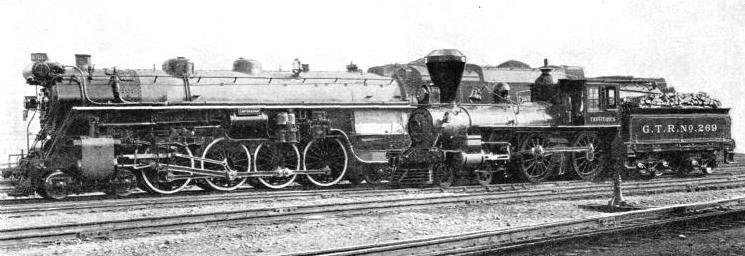
DWARFED. An early Canadian locomotive, “Trevithick”, standing by the Canadian National Railways’ 4-8-4 express engine “Confederation”. The “Trevithick” is an old wood-burning engine with an overall length of 60 ft, and weighs 33 tons. The “Confederation” has an overall length of 93 ft. It weighs, with tender, 319 tons in working order.
IT may be a surprise to many railway enthusiasts to realize that there should be such a diversity of locomotive types as is found today in all parts of the world. Certainly the number of different types is being reduced as rapidly as circumstances permit. When the grouping of British railways took effect, at the beginning of 1923, hundreds of different classes of engine came into the possession of each group. To have perpetuated them all, and to have continued to make and stock all the multiplicity of parts required for their maintenance, would have been wasteful. Many of the older types are therefore being scrapped, and, although considerable sentimental interest attaches to some of them, this extinction is inevitable. In their place new standard types are being rapidly built, and, when the process is complete, the number of type variations will be but a fraction of what it once was.
Even then, however, the number of different classes required will still be considerable. Variation is found chiefly in the number and arrangement of wheels, in the number of cylinders, and in the method of carrying the engine’s supplies of coal and water. It is the purpose of this chapter to explain some of the chief reasons for these differences.
First of all, there is the matter of coal and water. Generally speaking, a locomotive is provided with storage space for these two essentials, roughly in proportion to the average length of journey for which it is responsible. The tank locomotive carries its supplies on its own main frames, the water generally in large, flat side tanks on either side of the boiler, and the coal in a small bunker at the rear of the cab. Roughly 1,500 to 2,500 gallons of water and 2½ to 3 tons of coal can be accommodated in this way - sufficient, that is to say, for journeys of moderate length only.
The idea underlying the design of these self-contained locomotives is thus that of economy - that is, that they shall not expend power wastefully in hauling heavy tenders which carry supplies much in excess of their requirements. Further, the tank engine is designed in such a way as to give a good look-out at the rear end, so that it can be operated safely at speed with either the chimney or the bunker leading. This is not desirable with a tender engine, because of the bad look-out over a tender piled high with coal. For suburban service, therefore, a tank locomotive is ideal, as it does not require to be turned on a turn-table at the conclusion of each journey.
In Great Britain, too, the larger tank locomotives have been, and still are, used for journeys of considerable length. On the LMS, for example, it is a common practice to run one of the large 2-6-4 tank locomotives through between Preston and Whitehaven, a trip of 101½ miles. The former London, Brighton and South Coast Railway worked many of its principal express trains on the 60-minutes Victoria-Brighton express service with powerful 4-6-4 tank locomotives, and at one time 4-4-2 tank engines on the Brighton line were responsible for non-stop runs over the 84½ miles between Victoria and Fratton, a suburb of Portsmouth. But these were exceptional examples.
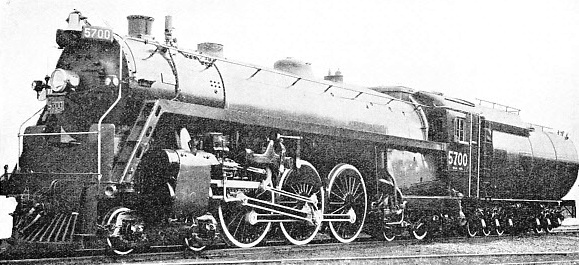
No. 5700, 4-6-4 EXPRESS LOCOMOTIVE of the Canadian National Railways. The cylinders measure 23 by 28-in, and the driving wheels have a diameter of 6 ft 8-in. The engine develops a tractive effort of 43,300 lb and an additional 10,000 lb with a “booster”. The overall length is 92 ft, and the weight over 331 tons.
Now, however, the view is increasingly taken that maximum economy is obtained by keeping a locomotive as continuously at work as possible, and also by taking advantage of its adaptability to the widest possible variety of duties. Its proper business of haulage is interrupted if it has to be taken to the coal stage for refuelling. Certain older tank engine types, such as the Brighton 4-6-4’s and the Southern 2-6-4’s, have now been rebuilt as tender locomotives, the former with the 4-6-0 and the latter with the 2-6-0 wheel arrangement, thus increasing their range of usefulness. Not only so, but there is also a general tendency to enlarge the tender locomotives, to increase their coal capacity. This tendency is marked on the LMS, where the latest tenders accommodate nine tons of coal and 4,000 gallons of water; and there has been somewhat similar growth on the Great Western Railway. The biggest British tenders are those attached to the Pacific locomotives of the LNER, which are designed to permit of 400-miles continuous journeys, in maximum loading conditions, without refuelling. This is essential when the “Flying Scotsman”, during the summer months, is making the non-stop run of 302¾ miles between London and Edinburgh; it is valuable on many other duties also, as there are several daily rostered turns for “Pacifics” covering either direction of the 188¼ miles between King’s Cross and York - 376½ miles in all - without re-coaling the tenders.
A few of these tenders have been further enlarged by the provision, down one side, of the corridor passage which permits the engine crew to be changed at the midway point of the London-Edinburgh line. The tenders last mentioned weigh no less than 62½ tons in running trim, and are the heaviest in Great Britain. Water capacity of tenders is largely ruled by the distance apart of the water-troughs of the owning company.
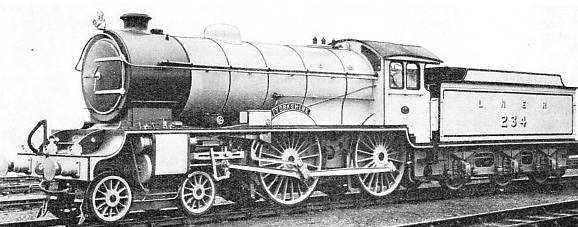
A “SHIRE” CLASS LNER three-cylinder express locomotive. The cylinders measure 17-in by 26-in. The coupled wheels are 6 ft 8-in diameter. The length of the engine and tender over buffers is 58 ft 8¾-in and the total wheelbase of the engine is 24 ft 11-in. The total heating surface is 1,669½ sq ft. Engines of this class were designed by Mr H N Gresley, Chief Mechanical Engineer of the LNER.
If the troughs are fairly close together, as on the LMS main line from Euston to Glasgow, which has eleven sets of troughs in just over 350 miles, the first at Bushey and the last at Carstairs, a smaller water capacity suffices; the standard type of tender fitted to the “Royal Scot” 4-6-0’s, for example, has tank space for only 3,500 gallons. But the LNER “Pacific” tenders, with troughs more widely spaced, have to accommodate 5,000 gallons. Similarly the Southern Railway, which has never laid water-troughs, invariably uses large eight-wheeled tenders, with 5,000 gallon tanks, for its West of England runs. The former London and South Western Railway, indeed, was the first to introduce bogie tenders on a large scale.
But the mightiest British tenders would look diminutive enough against some of the tenders with which modern Continental locomotives are equipped, and more Lilliputian still against the present-day American tenders. The American tender is often a vast structure on twelve wheels, nearly as long as a coach, and such capacities as 15,000 gallons of water and seventeen tons of coal are frequent. On American main lines it is common to re-fuel the engines, which make very long continuous runs, by means of coaling plants spanning the main lines at certain suitable points. In the middle of a run which appears in the time-table as non-stop, the engine is brought to rest under the plant, receives a fresh supply of fuel by way of a chute from the overhead bunkers, and proceeds, without having been detached from its train for the purpose of fuelling.
Next comes the all-important matter of the wheel arrangement, which in general decides the class of service for which an engine is intended. It is briefly expressed by the simple system of notation which has been frequently used in this work, but may not as yet have been fully understood by all readers.
 Every locomotive is carried by two different descriptions of wheel, either in fact or in theory. There are the coupled wheels, which transmit to the rail the power developed in the cylinders, and are responsible for the business of moving the locomotive and its train. The remaining wheels which, for purposes of distinction may be referred to as “idle” wheels - their function being to assist in distributing the weight of the engine over the track - are grouped before and behind the driving wheels.
Every locomotive is carried by two different descriptions of wheel, either in fact or in theory. There are the coupled wheels, which transmit to the rail the power developed in the cylinders, and are responsible for the business of moving the locomotive and its train. The remaining wheels which, for purposes of distinction may be referred to as “idle” wheels - their function being to assist in distributing the weight of the engine over the track - are grouped before and behind the driving wheels.
“LORD NELSON”, one of the most powerful locomotives owned by the Southern Railway. The engine has four cylinders, of 16½-in diameter by 26-in stroke. The driving wheels have a diameter of
6 ft 7-in, and the engine and tender weigh, in working order, 140 tons 5 cwt. “Lord Nelson” is the first of its class, and has the 4-6-0 wheel arrangement.
Taking one of the LNER “Pacifics” as an example, we have at the leading end two pairs of idle wheels - four wheels in all - then the six-coupled driving wheels, and then two more idle wheels under the firebox. The four, six, and two in sequence give the notation, which is 4-6-2. Should there be no idle wheels fore or aft, a cipher must be used; an engine of the GWR “King” class, therefore, with no idle wheels under the cab, is of the 4-6-0 type, while there are many familiar 0-6-0 and 0-8-0 freight classes in which all the wheels are coupled wheels.
In France the notation goes, more logically, perhaps, by axles instead of wheels. A French “Pacific”, therefore, is known as a 2-3-1 type locomotive instead of a 4-6-2. What is more, certain lines, such as the State Railways, use the notation as part of the engine number. Engine No. 231.654 on the Etat, therefore, would be, in effect, No. 654 of the 2-3-1 or “Pacific” type on that railway. The PLM goes even further, and uses the class letter as part of the number; 231.F.141 is thus “Pacific” No. 141 rebuilt as Class “F”.
Little need be said concerning the idle wheels of a locomotive. At the leading end it has been found that the provision of one or two axles with scope for radial movement, especially with engines intended for high-speed service, helps to keep down the wear of rails on a curved track, as well as enhancing the smoothness and safety with which the engine traverses the curve.
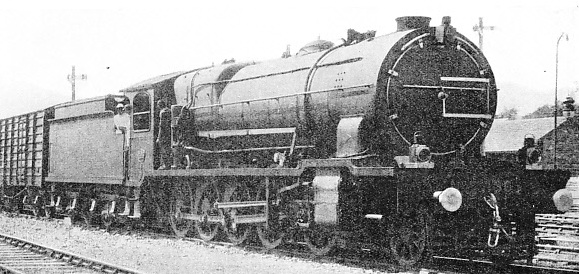
A 2-10-0 LOCOMOTIVE used for traffic on the Great Indian Peninsula Railway to haul heavy trains over difficult stretches of line. There are nearly 3,500 miles of track open in this system and some 970 locomotives are employed upon its lines.
In many engines this arrangement takes the form of a four-wheeled truck, or bogie, pivoted under the smoke-box; the bogie is free not only to swing on its pivot, but also, for a strictly limited amount, controlled by powerful springs, to slide in a lateral direction, so that the sharpest curves may be safely negotiated. Other types, especially those in which it is desired to restrict length or weight, have the bogie replaced by a single pair of wheels attached to a “pony truck”, with similar swinging motion, as in “Mogul” or “Mikado” locomotives.
At the rear end of the engine the design of the firebox is somewhat cramped if it has to be arranged immediately over the hindmost pair of coupled wheels, as in a 4-6-0 locomotive. But the use of an additional pair of idle wheels at the rear end permits unlimited firebox development clear of the coupled wheels. The LNER “Pacifics” and the “Atlantics” of the Great Northern type have wide fireboxes resting on the frames and extending over the full width of the engine; this would not have been possible with the 4-6-0 or the 4-4-0 wheel arrangements, which were, therefore, respectively extended to
4-6-2 and 4-4-2 for the purpose.
In America the fireboxes of some of the modern designs have grown to such immense size that a bogie is needed to carry their weight, instead of a single axle. In recent years, therefore, both 4-6-4 and 4-8-4 types have come into common use for express passenger service - that is six-coupled and eight-coupled locomotives with bogies both fore and aft. The only
4-6-4 tender locomotive in Great Britain is No. 10000 of the LNER; and this is not strictly of the 4-6-4 wheel arrangement, as the two rear axles are fixed, and do not work in a bogie truck.
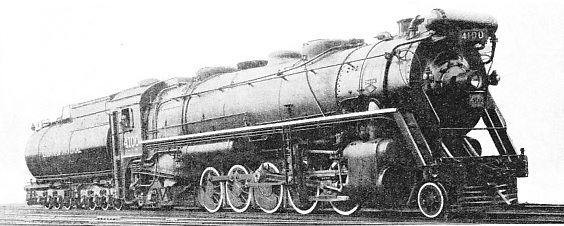
THE “SANTA FE” TYPE locomotive with the 2-10-2 wheel arrangement are used for the heaviest freight duties on the lines of the Canadian National Railways. The boilers of these giant goods engines have a diameter of 8 ft 8-in.
But the matter of chief importance is the number and diameter of the coupled wheels. In the earliest years of locomotive development it was realized that by coupling the driving wheels to another pair of wheels of equal size, the adhesion, or grip, between the tyres and the rails, on which the locomotive depends for the transmission of power from the cylinders to the rails, could be doubled. Even George Stephenson’s “Locomotion No. 1”, which ran the first train on the Stockton and Darlington Railway in 1825 and is still preserved on a pedestal at the Bank Top station at Darlington, had its two pairs of wheels linked by coupling rods, and thus was, in effect, of the 0-4-0 type.
In the second half of the nineteenth century, however, when tracks had improved sufficiently in strength to permit of the imposition of loads from 15 up to 18 tons on a single axle, “single-driver” locomotives became very popular for express service. Many such types were built, such as the famous Stirling 4-2-2 locomotives of the late Great Northern Railway, with their 8 ft driving wheels, the “Lady of the Lake” class 2-2-2’s on the London and North Western, and others. The idea underlying these designs was that less of the engine’s power would be expended in moving itself at high speed, as compared with a locomotive in which some of the power would be absorbed in the frictional resistance of coupled wheels. Even as late as the beginning of the present century, 4-2-2 locomotives were still being built.
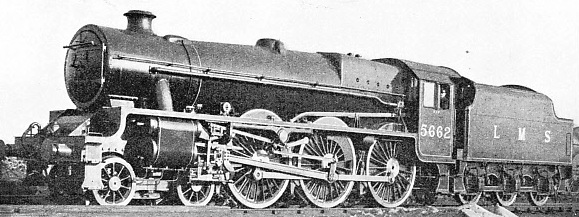
FOR EXPRESS PASSENGER WORK. A three-cylinder 4-6-0 LMS engine built at Derby in 1934. These 5XP locomotives have driving wheels of 6 ft 9-in diameter, cylinders 17 by 26-in, a total heating surface of 1,853 sq ft, and a working pressure of 225 lb per sq in. The weight of engine and tender in working order is 134¾ tons.
But as traffic demands grew, by way of heavier trains and faster times, greater tractive power became imperative; and bigger boilers and bigger cylinders needed, to make them effective, greater adhesion weights than could ever be imposed with safety in single driving wheels. So there came generally into use for express passenger service, first, four-coupled wheels, then six-coupled, and, extensively on the Continent and in America to-day, even eight-coupled wheels.
Early four-coupled passenger types in Great Britain had a variety of wheel arrangements. There were many 2-4-0 locomotives, of which perhaps the most famous were Webb’s “Precedents” of the London and North Western Railway, more familiarly known as “Jumbos”. One of these engines was “Charles Dickens”, which for many years worked the 8.30 am express from Manchester to Euston, and returned with the 4 pm express - a daily round of 367 miles via Stoke-on-Trent - and in so doing amassed a record total mileage of over two millions. Another was “Hardwicke”, noted as having participated in the 1895 “Race to Aberdeen” by running the West Coast “flyer” over the 141 miles from Crewe to Carlisle, Shap Summit included, in a time of 126 minutes, which has never been beaten.
A variant of this arrangement was adopted by Stroudley, the well-known Locomotive Superintendent of the London, Brighton and South Coast Railway, who reversed the order by arranging his driving wheels at the leading end and so building a 0-4-2 express locomotive. Of this type “Gladstone” is still preserved in the Railway Museum at York, resplendent in the gay livery of gamboge with which Brighton locomotives were originally decorated. These were the only 0-4-2 express locomotives that ever ran in Great Britain, though the Great Northern, London and South Western, and other lines built 0-4-2 tender locomotives with smaller driving wheels for mixed passenger and freight service.

A BELGIAN “MIKADO” type engines built by the Ateliers Metallurgiques at Tubize. It is used for international passenger trains on the Brussels-Arlon route. It can haul trains of 600 tons up gradients of 1 in 62½ at a sustained speed of nearly 25 miles an hour, and is one of the most powerful types of locomotive in Europe.
Then came into existence the characteristically British wheel arrangement, for express passenger trains, of four-coupled driving wheels with a leading bogie, of which the various railways in the United Kingdom must in the aggregate have built thousands. Some railways, such as the Midland and South Eastern and Chatham, used nothing else up to the time of the grouping. At the beginning of 1930, nearly 3,000 still remained, but since then the number has somewhat diminished. Even yet 4-4-0 locomotives of very modern types are still built, such as the “Schools” class 4-4-0’s of the Southern Railway - the heaviest and most powerful locomotives of this wheel arrangement yet devised - and the “Shires” and “Hunts” on the LNER, in both instances with three-cylinder propulsion.
Developing out of the 4-4-0 wheel arrangement there came the 4-4-2, or “Atlantic” type, first popularised in America, and first built in Great Britain by Mr. H. A. Ivatt on the Great Northern Railway in 1899. The fashion later spread up the East Coast until all the three partners in the East Coast Route - the Great Northern, North Eastern, and North British Railways - were using 4-4-2 engines for their principal express trains.
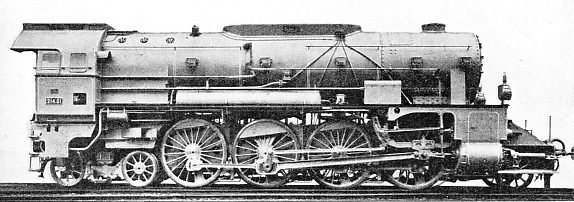
EIGHT-COUPLED WHEELS of 6 ft 5-in diameter are a remarkable feature of this Austrian express engine. These locomotives haul trains of 500 to 700 tons between Vienna and Salzburg. The enormous firebox and boiler alone weigh 35 tons. The connecting rods, measuring 13 ft 11-in in length, are unusually long.
Only the enlarged version of the Great Northern “Atlantics”, introduced in 1902, made full use of the space behind the coupled wheels to expand their fireboxes to the full width available. This has been the most successful of all British “Atlantic” designs, and to these veterans there is still entrusted some of the fastest running on the LNER system, such as the Pullman workings between London and Leeds, two of which are timed at just over 60 mph for the whole of the 156 miles between King’s Cross and Doncaster.
B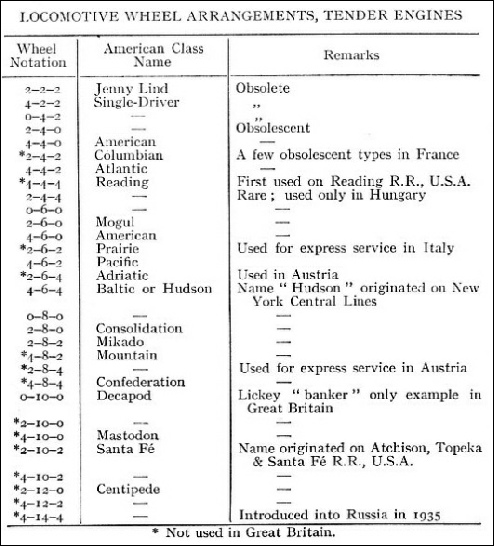 ut in the best track conditions, the maximum permissible weight on a pair of axles must not exceed 42 tons, and by the beginning of the present century it became clear that more adhesion weight would be necessary to keep pace with the increasing demands on locomotive power. It was the North Eastern Railway, in 1900, which first introduced six-coupled express locomotives into Great Britain. Following suit in 1902 with the engine “William Dean”, the Great Western Railway laid the foundation of the finest era in Swindon locomotive practice, which has produced, in succession, the “Saints”, “Stars”, “Castles”, and “Kings” - all 4-6-0 designs of progressively increasing size and power for express passenger service. Until the advent of the LMS turbine-driven locomotive No. 6202, the “Kings” reached a record, so far as Great Britain is concerned, by carrying 67½ tons on their three pairs of driving wheels, though such a figure as this is greatly exceeded in modern American designs. It is the aim of the Great Western locomotive department ultimately to work all passenger services (except a few light “push-and-pull” trains) exclusively with six-coupled locomotives.
ut in the best track conditions, the maximum permissible weight on a pair of axles must not exceed 42 tons, and by the beginning of the present century it became clear that more adhesion weight would be necessary to keep pace with the increasing demands on locomotive power. It was the North Eastern Railway, in 1900, which first introduced six-coupled express locomotives into Great Britain. Following suit in 1902 with the engine “William Dean”, the Great Western Railway laid the foundation of the finest era in Swindon locomotive practice, which has produced, in succession, the “Saints”, “Stars”, “Castles”, and “Kings” - all 4-6-0 designs of progressively increasing size and power for express passenger service. Until the advent of the LMS turbine-driven locomotive No. 6202, the “Kings” reached a record, so far as Great Britain is concerned, by carrying 67½ tons on their three pairs of driving wheels, though such a figure as this is greatly exceeded in modern American designs. It is the aim of the Great Western locomotive department ultimately to work all passenger services (except a few light “push-and-pull” trains) exclusively with six-coupled locomotives.
Other notable British 4-6-0 types are the “Royal Scots”, and the “5XP” class (“5X” as the power classification and “P” for “passenger”) on the LMS, the latter slightly inferior in weight to the former, and so having a wider range of action, as they may run over certain sections of line which are forbidden to the “Royal Scots”. The chief Southern Railway services are worked by the 4-6-0 “Lord Nelsons” and “King Arthurs”, the former, with four cylinders, more powerful than the two-cylinder “King Arthurs”, though the difference in weight between the two types is no more than two tons. Then on the London and North Eastern Railway there are the three-cylinder 4-6-0 “Sandringham” class engines - a modern design built chiefly for use over the Great Eastern Section, where certain limitations of engine weight operate.
For mixed traffic service the 4-6-0 wheel arrangement is also becoming increasingly popular, its most extensive exemplification being in the “Hall” class 4-6-0’s of the GWR, and the new Stanier series numbered from 5000 upwards on the LMS Railway. In these types the driving wheel diameter is lowered from the 6 ft 8 in or 6 ft 9 in of the express engines to 6 ft, to make the engines more adaptable for heavy freight as well as for passenger service. Notwithstanding their smaller wheels, however, both these types have been timed at speeds well in excess of eighty miles an hour.

THE “INTERNATIONAL LIMITED” is hauled by this Canadian National Railways locomotive over United States territory between Port Huron and Chicago. The powerful engine has a 4-8-4 wheel arrangement. A booster-driven bogie truck carries the firebox.
But the most freely built of all mixed traffic or “general purpose” tender locomotive types in Great Britain has been the
2-6-0 or “Mogul”, and in this building all four railway groups have shared, the Great Western and LNER in particular. Most of the “Moguls” have driving wheels 5 ft 8-in in diameter, but even this reduction of size has not prevented them, on occasion, from reaching the eighty-miles-per-hour mark.
Logically developing from the 4-6-0 and 4-4-2 wheel arrangements, there has come the 4-6-2, or “Pacific” type. It was first introduced by the Great Western Railway, who in 1908 built “The Great Bear”. But the engine was in advance of its time, and, further, its long wheelbase proved unsuitable for the winding main line to Devon and Cornwall west of Reading. After some years of use on secondary duties between Paddington and Bristol, therefore, “The Great Bear” was converted to a 4-6-0, and became No. 111, “Viscount Churchill”, of the “Castle” class.
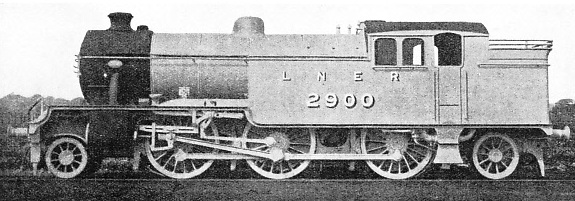
A 2-6-2 LNER tank engine in 1930. The three cylinders measure 16 by 26-in. The total heating surface is 1609 sq ft, the grate area 22.08 sq ft, and the steam pressure 180 lb per sq in. The weight in working order is 84 tons.
But no such fate succeeded the introduction of the first “Pacific” on the Great Northern Railway in 1922. Since then nearly one hundred of these magnificent locomotives have been put into service, and some of their feats of unassisted weight haulage - with trains reaching maximum loaded tonnages of 650 and even 700 tons, on ordinary schedules at holiday times - have been without parallel in Great Britain. Five “Pacifics” were also built by the late North Eastern Railway immediately before the grouping. The only others in service in Great Britain (apart from miniature railways) are “The Princess Royal”, “Princess Elizabeth”, and the turbine-driven No. 6202 on the LMS. On June 27, 1935, “The Princess Royal”, hauling 475 tons, beat the record from Crewe to Willesden Junction, averaging 70.7 mph.
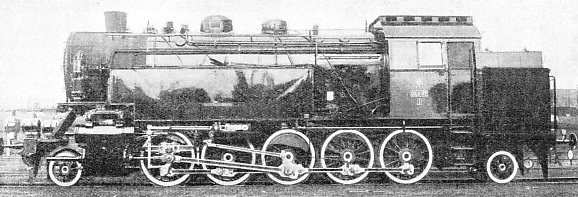
PASSENGER TANK LOCOMOTIVES of the 2-10-2 wheel arrangement are used on the Polish State Railways. The diameter of the coupled wheels is 4 ft 9⅛-in, cylinder are 24⅞-in by 27⅝-in and the length of the engine over buffers is 50 ft 3¼-in. The maximum tractive effort is 37,919 lb.
Eight-coupled wheels are no novelty for express passenger service in other countries; 4-8-2, or “Mountain” type engines are freely used on the PLM, State, and Eastern Railways of France; 4-8-0’s on the Paris-Orleans; 2-8-2’s in Germany and Belgium; and 2-8-4’s in Austria. In America also 4-8-2’s are common, supplemented on some lines by 4-8-4’s. Although in early days it was thought that the coupling of axles would hamper an engine’s capacity for speed, it is a striking fact that the Paris-Orleans 4-8-0 locomotives have been tested to 91 mph, and that the world’s highest records with steam have all been made by six-coupled engines, culminating in the 108 mph of the LNER 4-6-2 engine “Papyrus”, in March, and the 119 mph of the German 4-6-4 streamlined locomotive in June, 1935. In most parts of the world, therefore, fast and heavy passenger service is undertaken principally by “Pacifics”.
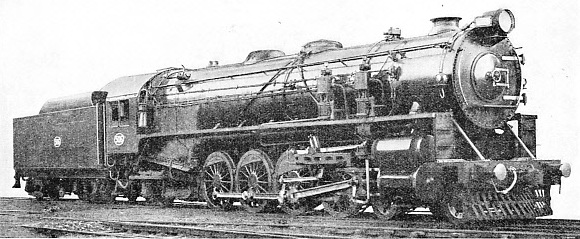
BRITISH-BUILT. A “Mountain” type locomotive with the 4-8-2 wheel arrangement. The first engines of this type were intended to work trains in mountainous districts. The type was originally used on the Chesapeake and Ohio Railroad.
For fast freight service the various descriptions of “mixed traffic” locomotives, 4-6-0 and 2-6-0, already mentioned, are largely used, supplemented to no small extent in these days by express passenger locomotives. But in the haulage of minerals and stopping goods trains, hauling power is the primary consideration and speed a secondary one. Driving wheels are therefore reduced in size to 5 ft or 4 ft 6-in, and in many freight types all idle wheels are dispensed with, so that the whole of the engine’s weight may be available for adhesion. This produces the numerous 0-6-0 type, and many 0-8-0’s (chiefly on the LMS), while Britain lays claim to one 0-10-0 locomotive - the powerful banking engine built some years ago by the Midland Railway for assisting trains up the 1 in 37¾ Lickey incline, near Bromsgrove. This two-miles run really called for a tank locomotive design, but for this powerful machine to have carried its supplies of coal and water on its own main frames would have caused an undesirable concentration of weight, so that a tender design was decided on.
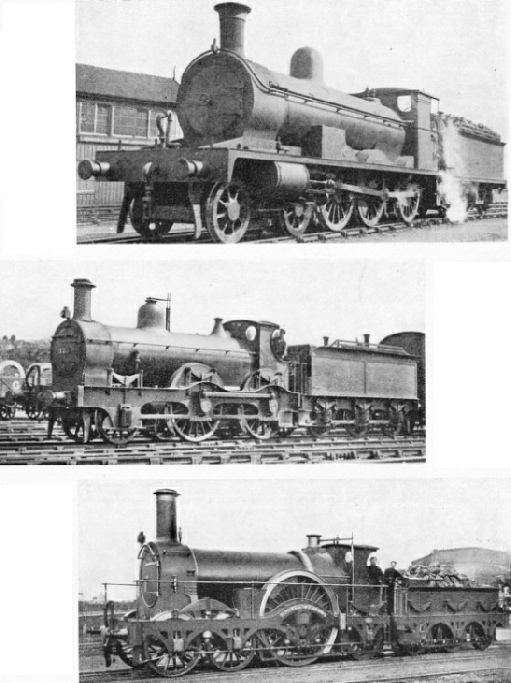 THE FIRST 4-6-0 LOCOMOTIVES in Britain were the Jones goods engines originally used on the Highland Railway, now in the possession of the LMS. The engine illustrated here was built in 1894 and weighs in working order 56 tons, without tender. At the time of building these engines were among the largest in Great Britain, but now appear diminutive in comparison with modern
THE FIRST 4-6-0 LOCOMOTIVES in Britain were the Jones goods engines originally used on the Highland Railway, now in the possession of the LMS. The engine illustrated here was built in 1894 and weighs in working order 56 tons, without tender. At the time of building these engines were among the largest in Great Britain, but now appear diminutive in comparison with modern
4-6-0 and 4-6-2 locomotives.
A 2-4-0 LOCOMOTIVE of the former Midland Railway. It was built at the Derby Works in 1867, and is notable for its outside frames, with outside cranks and bearings. The type is now almost extinct. The Midland Railway was one of the constituent companies of the LMS. The locomotive illustrated is shown in its LMS livery.
BUILT IN 1898. A Great Western broad-gauge engine of the “Iron Duke” class. The wheel arrangement is difficult to describe, as the leading axles being fixed and not a bogie, this is not strictly the 4-2-2- type. With their 8 ft driving wheels, these locomotives performed some noteworthy feats of speed.
On the continent of Europe ten-coupled freight locomotives are common, generally with the 2-10-0 wheel arrangement, while in America 2-10-2’s and 2-10-4’s are favourite wheel arrangements for heavily-graded routes. Engines with twelve-coupled wheels have been built occasionally, such as the 4-12-2 type of the Union Pacific of the USA, and 2-12-2 tank locomotives in Java, while the Russians have lately gone even farther by designing locomotives of the 4-14-4 type, with seven axles coupled, and bogies fore and aft, for heavy freight service.

A “GLADSTONE” AND A “TERRIER”. Locomotives of the former type were designed by W. Stroudley for the London, Brighton and South Coast Railway in 1882, and were notable for their front-coupled driving wheels. They were the only engines so built in Great Britain for express passenger service. Behind this early express locomotive can be seen one of the renowned little 0-6-0 “Terrier” class tank engines also owned by the LB & SCR.
Tank locomotives comprise just as great a variety of wheel arrangements. In Great Britain, suburban tank engines of earlier years were chiefly of the 2-4-2 (“double-enders”) and 0-4-4 types; then came the expansion to 4-4-2; and after that the necessity for increased adhesion led to the design of 0-6-2, 0-6-4, 2-6-2, 4-6-2, and 2-6-4 types. Of recent years the
2-6-2 wheel arrangement has been most favoured, with the 2-6-4 for longer-distance work.
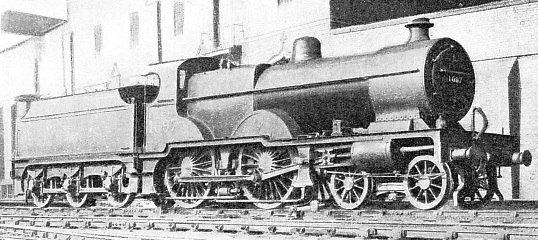 4-4-0 COMPOUND LOCOMOTIVE built at the London, Midland and Scottish Railway’s works at Derby in 1925. There are at present some 230 locomotives of this type in service. These engines have one high-pressure cylinder inside and two low-pressure cylinders outside.
4-4-0 COMPOUND LOCOMOTIVE built at the London, Midland and Scottish Railway’s works at Derby in 1925. There are at present some 230 locomotives of this type in service. These engines have one high-pressure cylinder inside and two low-pressure cylinders outside.
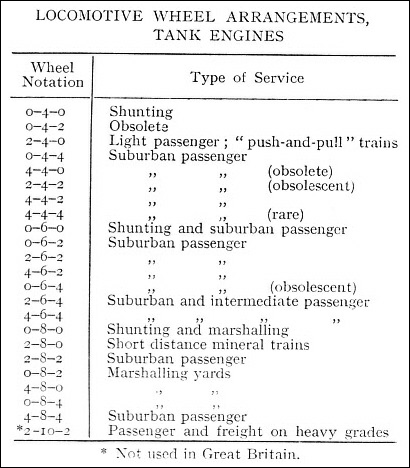 A few lines favoured 4-6-4 tank locomotives, the most powerful of which were the eight engines of this wheel arrangement built by the London, Brighton and South Coast Railway; but the majority of these types were in reality express engines without tenders. Most of them have now either been converted to tender engines, or are scrapped or regarded as obsolescent.
A few lines favoured 4-6-4 tank locomotives, the most powerful of which were the eight engines of this wheel arrangement built by the London, Brighton and South Coast Railway; but the majority of these types were in reality express engines without tenders. Most of them have now either been converted to tender engines, or are scrapped or regarded as obsolescent.
Round Paris much use is made of 2-8-2 and 4-8-4 tank locomotives on the busy suburban services of that city; and one of the most remarkable railway spectacles in existence, on the “push-and-pull” suburban trains of the State Railways into and out of St. Lazare terminus, is to see one of the standard 2-8-2 tanks propelling nine bogie coaches with the driver as far away from the footplate as the outermost end of the ninth coach.
For freight service eight-coupled wheels are popular on the Great Western Railway, whose 2-8-0 mineral tank engines are now in course of conversion to the 2-8-2 wheel arrangement to provide increased bunker space. Indeed, these bunkers are of record size for Great Britain, as they accommodate six tons of coal. These are chiefly used in South Wales, on the short journeys between the coal-mines and the ports at which shipment takes place. For working marshalling yards several varieties of eight-coupled wheel arrangements are in use, including 0-8-0, 0-8-2, 0-8-4, 4-8-0, and others. Then there are the various descriptions of “Beyer-Garratt” articulated locomotives, which are in effect tank engines of vast size, but these have already been so fully described that further reference is unnecessary here. “Beyer-Garratt” locomotives are among the types detailed in the chapter “Articulated Locomotives”, which appears later in this work. As explained in that chapter, the arrangement of the wheels of an articulated locomotive calls for a special form of wheel notation.
Subsequent chapters will describe in detail - with tables of their principal dimensions, and a comparison of their leading features - the modern express passenger, mixed traffic, freight, and tank locomotive types in use in Great Britain. Other chapters will deal with the outstanding modern designs on the continent of Europe and in America.
Attention will also be paid to experimental locomotives, such as those utilizing ultra high-pressure steam, those propelled by turbines instead of cylinders, connecting-rods and cranks, and similar locomotive developments.

AN AMERICAN GIANT ENGINE working on the Chesapeake and Ohio Railroad. The wheelbase of locomotive and tender is 97 ft 9¼-in and the driving wheels have a diameter of 4 ft 9-in. The boiler pressure in 205 lb, the total heating surface 8,328 sq ft, and the tractive effort 103,500 lb.
You can read more on “The ‘Consolidation’ 2-8-0”, “A Famous Locomotive Type” and
“Some Famous Singles” on this website.






 Every locomotive is carried by two different descriptions of wheel, either in fact or in theory. There are the coupled wheels, which transmit to the rail the power developed in the cylinders, and are responsible for the business of moving the locomotive and its train. The remaining wheels which, for purposes of distinction may be referred to as “idle” wheels -
Every locomotive is carried by two different descriptions of wheel, either in fact or in theory. There are the coupled wheels, which transmit to the rail the power developed in the cylinders, and are responsible for the business of moving the locomotive and its train. The remaining wheels which, for purposes of distinction may be referred to as “idle” wheels -




 ut in the best track conditions, the maximum permissible weight on a pair of axles must not exceed 42 tons, and by the beginning of the present century it became clear that more adhesion weight would be necessary to keep pace with the increasing demands on locomotive power. It was the North Eastern Railway, in 1900, which first introduced six-
ut in the best track conditions, the maximum permissible weight on a pair of axles must not exceed 42 tons, and by the beginning of the present century it became clear that more adhesion weight would be necessary to keep pace with the increasing demands on locomotive power. It was the North Eastern Railway, in 1900, which first introduced six-



 THE FIRST 4-
THE FIRST 4-
 4-
4- A few lines favoured 4-
A few lines favoured 4-